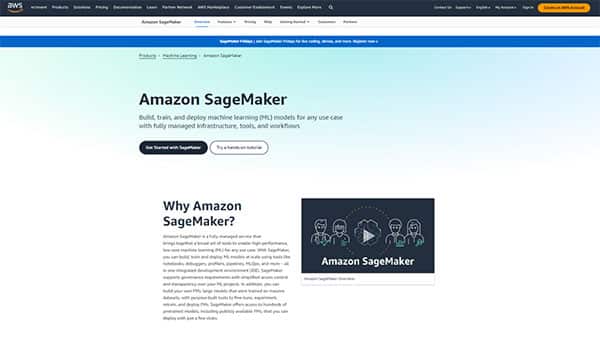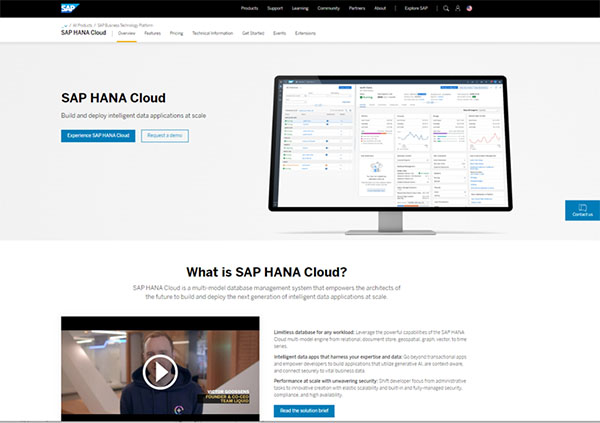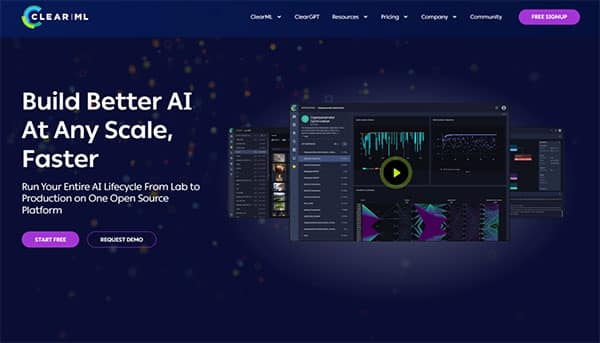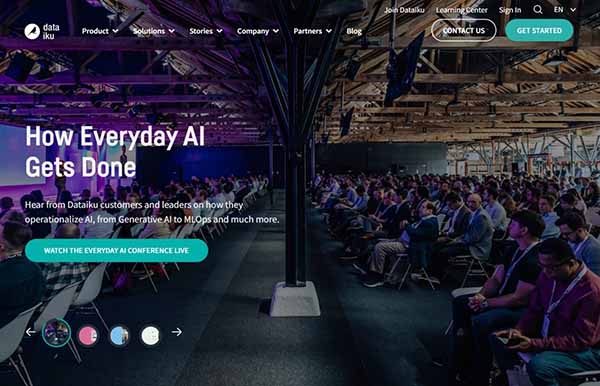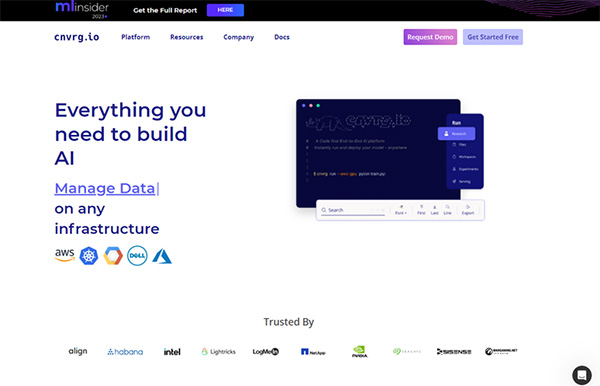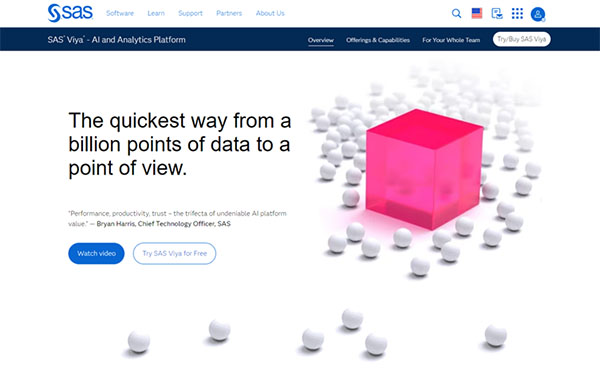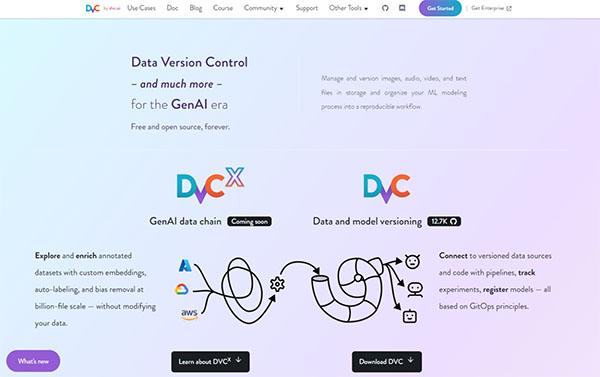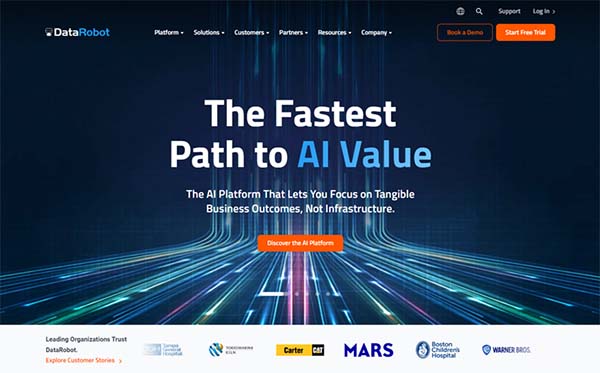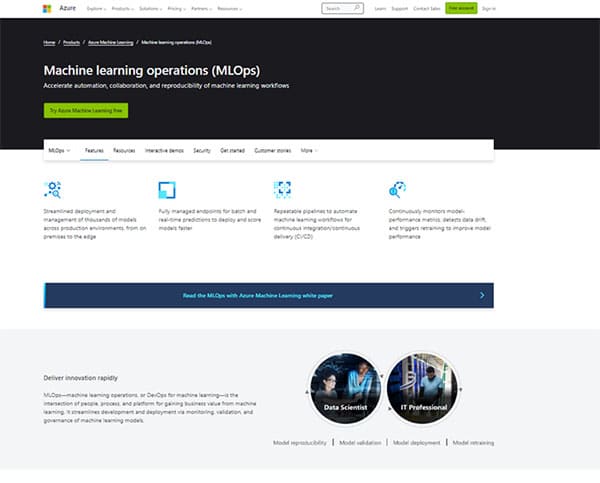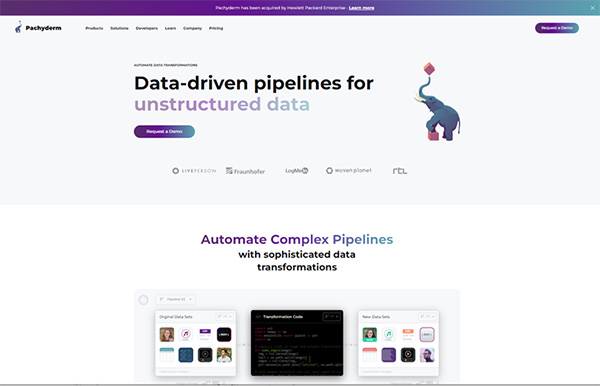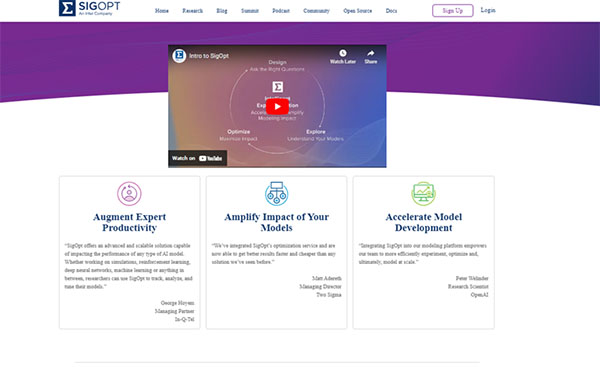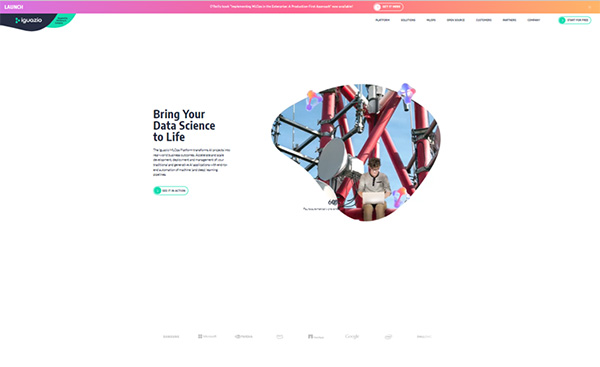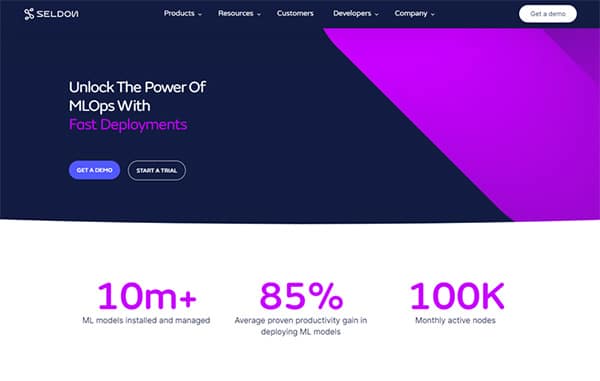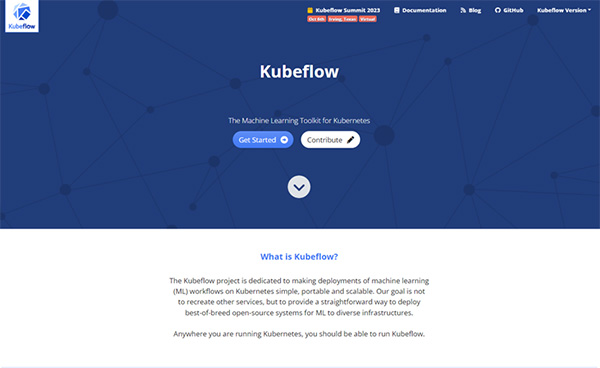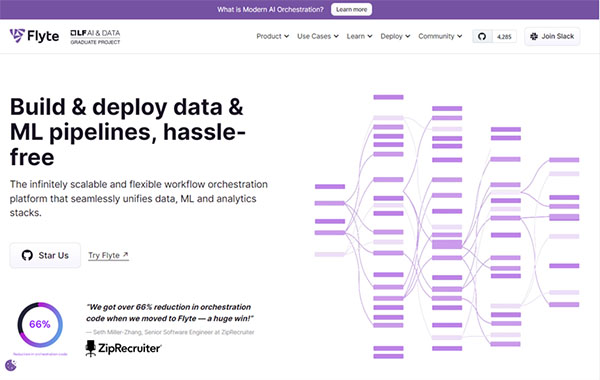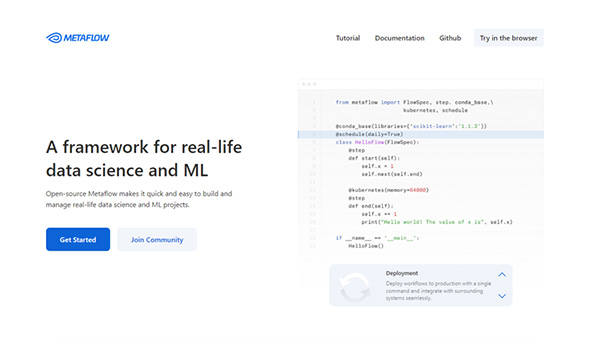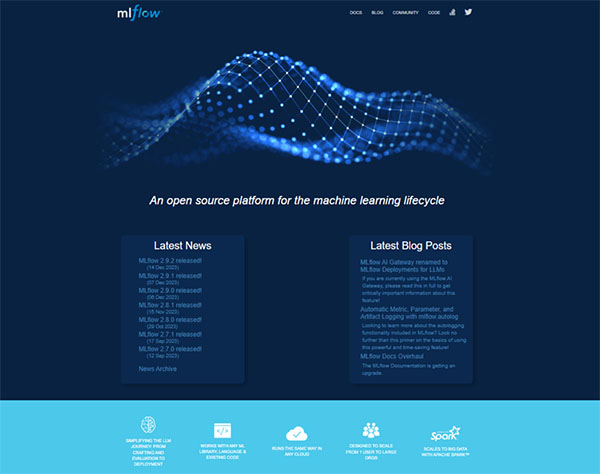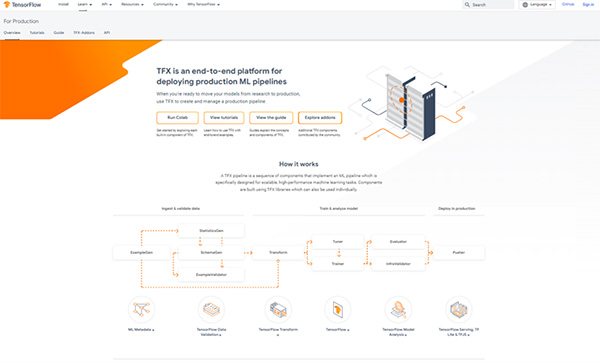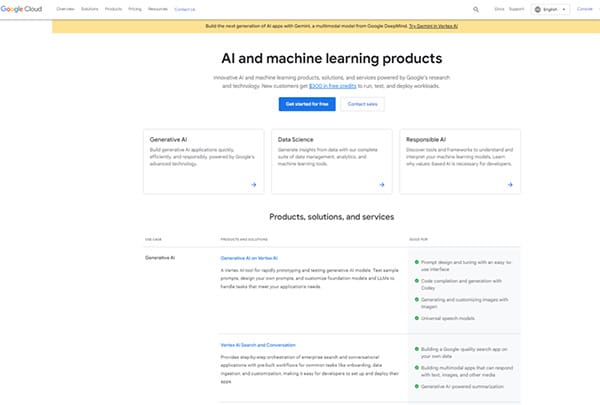20 Best MLOps Platforms
Machine Learning Operations is a rapidly evolving field that combines machine learning, data engineering, and DevOps to streamline and automate the entire machine learning lifecycle. As businesses increasingly leverage machine learning to drive decision-making and operational efficiency, the need for robust MLOps platforms has never been greater. These platforms play a pivotal role in managing and deploying machine learning models, ensuring scalability, reliability, and seamless collaboration between data scientists, machine learning engineers, and operations teams.
The Best MLOps Platforms not only facilitate the development and deployment of machine learning models but also provide tools for monitoring, versioning, and managing these models. They help organizations to automate less critical tasks, allowing data scientists and engineers to focus on more complex aspects of model development and deployment. This article aims to guide you through the process of choosing the Best MLOps Platform for your specific needs, highlighting the key features and considerations to keep in mind.
What is an MLOPS Platform?
MLOps, short for Machine Learning Operations, is a set of practices that aim to automate and simplify machine learning (ML) workflows and deployments. It is a practice that unifies ML application development with ML system operations, automating and standardizing processes across the ML lifecycle. These processes include model development, testing, integration, release, and infrastructure management.
An MLOps platform is a tool or system that facilitates the implementation of MLOps practices. It provides a collaborative environment for all stakeholders involved in ML projects, including data scientists, engineers, and risk auditors. The platform helps to expedite the ML efforts of organizations by providing a blueprint strategy to create repeatable and streamlined processes.
Key features of a comprehensive MLOps platform include:
- A collaborative experience for all stakeholders
- A user-first, modular architecture
- An emphasis on optimization
- An ability to handle end-to-end ML workflows
MLOps platforms also provide solutions for data management and preprocessing, experimentation and model development, model deployment, monitoring, and governance. They should seamlessly integrate with popular machines.
The Need for Best MLOps Platform
In today’s data-driven world, the ability to efficiently manage and deploy machine learning models is crucial. MLOps platforms provide a structured approach to this, ensuring that no critical steps are missed in the model development process. They offer a well-defined roadmap for all the crucial steps, from data preparation and feature engineering to model training, validation, and deployment.
Moreover, MLOps platforms bridge the gap between data scientists, machine learning engineers, and operations teams, fostering collaboration and scalability. They enable efficient resource utilization, enhance productivity, and ensure the optimal operation of machine learning models. With the right MLOps platform, organizations can effectively manage their machine learning models, ensuring they deliver accurate predictions over time and provide significant business value.
20 Best MLOps Platforms
- AWS Sagemaker
- SAP HANA Cloud
- ClearML
- Dataiku
- cnvrg.io
- SAS Viya
- Data Version Control (DVC)
- Valohai
- Datarobot
- Machine Learning Operations (MLOps)
- Pachyderm
- Sigopt
- Iguazio
- Seldon
- Kubeflow
- Flyte
- Metaflow
- MLFlow
- TensorFlow Extended (TFX)
- Google Cloud AI
How to choose the Best Best MLOps Platform?
Choosing the Best MLOps Platform depends on several factors. First, consider your specific use case and the capabilities you require. For instance, if you’re testing a proof of concept, you might need features for data preparation, feature engineering, model prototyping, and validation. On the other hand, if you require frequent retraining, such as in fraud detection, you might need a platform that offers unified model development and deployment workflows.
Another important consideration is the platform’s integration with your existing tools and workflows. The best MLOps platform should seamlessly integrate with your data sources, data engineering platforms, code repositories, and monitoring systems. Also, consider the commercial details, including the pricing models, vendor support, and maintenance terms. Ensure they fit your budget and scaling requirements.
Lastly, consider the platform’s data governance and security features. Some platforms offer more robust data security than others. If you don’t already have a strong data security tool, consider selecting an MLOps platform with comprehensive data security capabilities.
Best MLOps Platforms (Free and Paid)
1. AWS Sagemaker
AWS Sagemaker is a fully managed service that provides a broad set of tools to facilitate high-performance, cost-effective machine learning (ML) for any use case. It allows users to build, train, and deploy ML models at scale using various tools such as notebooks, debuggers, profilers, pipelines, and MLOps, all within an integrated development environment (IDE). AWS Sagemaker supports governance requirements by providing simplified access control and transparency over ML projects. It also offers access to hundreds of pre-trained models that can be deployed with just a few clicks.
What does AWS Sagemaker do?
AWS Sagemaker is designed to streamline the process of building, training, and deploying machine learning models. It provides a complete set of tools that enable data scientists and developers to prepare, build, train, and deploy high-quality ML models quickly. AWS Sagemaker supports leading ML frameworks, toolkits, and programming languages, allowing users to choose the tools that best fit their project requirements. It also offers features for maintaining high-quality models, explaining ML models, detecting bias, and deploying ML solutions for various use cases.
AWS Sagemaker Key Features
Integrated Development Environment (IDE): AWS Sagemaker provides an all-in-one IDE that brings together a broad set of tools for building, training, and deploying ML models.
Support for Leading ML Frameworks and Languages: AWS Sagemaker supports leading ML frameworks, toolkits, and programming languages, providing flexibility to users in choosing the tools that best fit their project requirements.
Model Training and Deployment: AWS Sagemaker allows users to train ML models at scale and deploy them with just a few clicks.
Pre-Trained Models: AWS Sagemaker offers access to hundreds of pre-trained models that can be deployed quickly, saving time and resources.
Governance and Transparency: AWS Sagemaker supports governance requirements by providing simplified access control and transparency over ML projects.
Cost-Effective: AWS Sagemaker is designed to be a high-performance, low-cost solution for machine learning, making it accessible for various use cases.
AWS Sagemaker Pros and Cons
AWS Sagemaker Pros
- Comprehensive toolset for ML
- Supports leading ML frameworks and languages
- Easy model training and deployment
- Access to pre-trained models
- Strong governance and transparency features
- Cost-effective
AWS Sagemaker Cons
- Can be complex for beginners
- Costs can add up with extensive use
- Dependency on AWS ecosystem
AWS Sagemaker Pricing Plans
AWS Sagemaker offers a flexible pricing model that users can get by using the AWS pricing calculator.
AWS Sagemaker accepts debit and credit cards.
2. SAP HANA Cloud
SAP HANA Cloud is a powerful, cloud native MLOps platform that has been recognized for its top-rated performance and innovative capabilities. It is a product of SAP, a leading global research and advisory firm, and has been acknowledged for its excellence in the realm of cloud DBMS. SAP HANA Cloud is designed to reduce the complexity of multi-cloud or hybrid environments, providing a comprehensive suite of advanced technologies for multi-model data processing. It offers a container-based architecture that executes applications in any programming language, allowing for a variety of runtimes and backing services.
What does SAP HANA Cloud do?
SAP HANA Cloud serves as a database and data management service for SAP Analytics Cloud, SAP Data Warehouse Cloud, SAP Business Applications, and third-party applications. It provides several storage options, including a powerful in-memory database system that combines OLTP and OLAP technologies, complemented with a multimodel engine for relational and document data. SAP HANA Cloud also offers a market-leading analytics data platform, providing high-performance, on-demand analytics. It is designed to streamline administrative tasks, making it easier for businesses to focus on their core operations.
SAP HANA Cloud Key Features
Power in-Cloud Platform: SAP HANA Cloud offers a powerful in-cloud platform that provides a low cost of total ownership and elasticity within the cloud platform. It allows for real-time processing of data stored in the HANA database and analytical reports.
Centrally Stored: SAP HANA Cloud is centrally stored, with data coming from multiple data sources. This feature simplifies and streamlines access to all data in one storage solution, helping to fix issues like data duplication.
High Performance: SAP HANA Cloud offers easy scaling up/down with no additional costs and can process both transactional and analytical data. It provides high compute and storage capabilities.
Application Development: SAP HANA Cloud supports application development, allowing developers to create applications that utilize generative AI, are context-aware, and connect securely to vital business data.
Security: SAP HANA Cloud places a high emphasis on security, providing robust data protection and compliance measures.
Integration: SAP HANA Cloud integrates seamlessly with other SAP offerings, allowing for a unified and efficient workflow.
SAP HANA Cloud Pros and Cons
SAP HANA Cloud Pros
- High performance
- Scalability
- Security
- Integration capabilities
- Application development support
- Centralized storage
SAP HANA Cloud Cons
- Limited hardware compatibility
- High initial investment
- Not all ERP products supported
SAP HANA Cloud Pricing Plans
SAP HANA Cloud offers a variety of pricing plans to cater to different needs.
Guided Experience: This plan provides a comprehensive introduction to SAP HANA Cloud, explaining key features and specific benefits while introducing the newest technological advances.
Free Tier: SAP HANA Cloud offers a free tier option that allows users to explore the capabilities of SAP HANA Cloud within the SAP BTP free tier. When ready, users can switch to the paid service plan smoothly, without losing their work.
SAP HANA: The pricing for SAP HANA Cloud, priced at $9.84 per month, is based on the concept of Capacity Units (CUs). This adaptable approach to pricing allows for any workload on any hyperscaler. The number of CUs required is determined by the unique workload, with the ability to tailor the combination of required services within SAP HANA Cloud. The services that contribute to CU consumption are the core application (compute and storage), integrated multi-tier storage including in-memory, native storage extension (disk) and relational data lake, data integration, and multi-model engines.
SAP HANA Cloud accepts debit and credit cards, and bank wire transfer for payments.
3. ClearML
ClearML is a unified, open-source platform designed to streamline the entire machine learning lifecycle, from research to production. It is a comprehensive tool that allows developers to easily develop, integrate, ship, and improve AI/ML models at any scale. ClearML is built by developers for developers, offering a flexible and customizable experience that can be integrated with just two lines of code. It is designed to eliminate the need for pricey walled gardens, vendor lock-ins, or stitching together fragmented point solutions, making it a preferred choice for over 1,300 forward-thinking enterprises.
What does ClearML do?
ClearML provides a robust platform for managing and executing machine learning operations (MLOps). It supports the most common workflows for exploration, model management, and model deployment. ClearML’s capabilities extend to automatic experiment tracking, data versioning, pipeline orchestration, and hyperparameter optimization. It also offers an API for developers and coders, providing a marvel of adaptability. ClearML’s automated data logging tracks every change for every run, making tasks repeatable without consuming a lot of storage or managing tons of credentials. It also provides complete visibility of your data’s lineage and where it is being used in tasks and pipelines.
ClearML Key Features
Automated Experiment Tracking: ClearML automatically logs, compares, and reproduces any experiment, making it easy to track and manage your machine learning models.
Data Versioning: ClearML tracks changes to your datasets and makes them easily accessible, ensuring that your data is always up-to-date and reliable.
Pipeline Orchestration: ClearML allows you to orchestrate pipelines from code, streamlining the process of managing complex workflows.
Hyperparameter Optimization: ClearML supports hyperparameter optimization, helping you to fine-tune your models and achieve better results.
API for Developers: ClearML provides a Pythonic interface to access its backend REST API, offering a flexible and adaptable tool for developers.
Cloud Agnostic: ClearML is a cloud-agnostic platform, meaning it can be deployed on any cloud service, providing flexibility and ease of use.
ClearML Pros and Cons
ClearML Pros
- Comprehensive MLOps platform
- Automated experiment tracking
- Data versioning
- Pipeline orchestration
- Hyperparameter optimization
- API for developers
- Cloud agnostic
ClearML Cons
- Limited to Python language
- User interface can be challenging to navigate
- No support for parallel computation frameworks like Spark, Dask, or Ray out of the box
ClearML Pricing Plans
ClearML offers four different pricing plans to cater to different needs and budgets.
Free Plan: This plan generously admits 3 users for free with basic functionality and sufficient resource quota.
Pro Plan: The Pro plan provides 20% extra quota for storage, metrics, and API calls for $15 per user per month. It also includes additional features in pipeline orchestration and management.
Scale Plan: The Scale plan offers more advanced features and resources, but the price is not publicly listed.
Enterprise Plan: The Enterprise plan offers the most comprehensive features and resources, including private server and cluster, but the price is not publicly listed.
ClearML accepts debit and credit cards, and bank wire transfer for payments.
4. Dataiku
Dataiku stands as a prominent MLOps platform in the realm of Machine Learning Operations, offering a suite of tools designed to facilitate the end-to-end lifecycle of machine learning models. It is engineered to streamline the process from data preparation to deployment and monitoring of AI models, ensuring that businesses can leverage their data effectively. Dataiku’s platform is recognized for its ability to cater to a diverse range of users, from data scientists to business analysts, by providing both code-friendly and visual interfaces for developing AI solutions.
What does Dataiku do?
Dataiku serves as a comprehensive platform that enables organizations to harness the power of their data through collaborative data science and machine learning. It provides an integrated environment where teams can work together to explore, prototype, build, and deliver AI-driven products. Dataiku simplifies the process of data preparation, model training, and deployment, while also offering robust capabilities for monitoring and maintaining AI models in production. The platform’s versatility allows for a wide array of data tasks, including predictive modeling, data processing, and analytics, making it an asset for companies looking to innovate with AI.
Dataiku Key Features
Collaborative Environment: Dataiku fosters collaboration among team members with different skill sets, allowing both coders and non-coders to work together seamlessly on data projects.
Extensibility: The platform can be extended with public and proprietary plugins and custom applications, enabling users to integrate specialized code and workflows into their projects.
AutoML: Dataiku’s AutoML feature accelerates model development with a guided framework, providing built-in guardrails and explainability for users at all levels of expertise.
DataOps: The visual flow in Dataiku represents the pipeline of data transformations, offering a clear overview of the data lifecycle and facilitating efficient project management.
Generative AI: Dataiku supports Generative AI, allowing teams to move beyond experimental stages and deploy AI models that can generate new content or data.
Integration: Dataiku integrates smoothly with existing infrastructure, whether on-premises or in the cloud, and supports fully managed elastic AI powered by Spark and Kubernetes for optimal performance.
Dataiku Pros and Cons
Dataiku Pros
- Intuitive UI
- Extensive plugin ecosystem
- Robust AutoML capabilities
- Strong collaboration features
- Scalable infrastructure integration
- Generative AI support
Dataiku Cons
- Steep learning curve for beginners
- Limited visualization options
Dataiku Pricing Plans
Dataiku offers a range of pricing plans to accommodate different user needs and organizational sizes.
Free Edition: This plan is designed for individual users or small teams just starting with AI and includes basic features for data preparation and analytics.
Discover: Aimed at small to medium-sized teams, this plan offers more advanced features, including additional database connectors and limited automation.
Business: For larger teams requiring more robust capabilities, the Business plan provides enhanced collaboration tools and full automation options.
Enterprise: The most comprehensive plan, Enterprise, is tailored for organizations seeking enterprise-grade features, including role-based security, LDAP support, and unlimited users.
Users need to contact Dataiku sales team for custom pricing.
Dataiku accepts debit and credit cards for payments.
5. cnvrg.io
cnvrg.io is a full-stack machine learning operating system that provides a comprehensive suite of tools and services for AI developers. It is designed to streamline and simplify the process of building and deploying machine learning models, offering a scalable MLOps platform that can be easily integrated with existing infrastructures. As a two-time winner of the AI Breakthrough Awards, cnvrg.io has established itself as a leading platform in the field of machine learning and AI development.
What does cnvrg.io do?
cnvrg.io is a data science platform that assists businesses across various industries, including finance, healthcare, media, IT, aerospace, and automobile, in building, automating, and managing the entire machine learning lifecycle, from research to deployment. It offers a collaborative online workspace, experiment tracking, data visualization, multiple document format support, data import, and user management. It is designed to help users navigate machine learning with dashboards, reproducible data science, dataset organization, experiment tracking and visualization, and a model repository.
cnvrg.io Key Features
Scalable MLOps Platform: cnvrg.io provides a scalable MLOps platform that can be bundled with Lenovo ThinkSystem AI-Ready servers, creating a managed, coordinated, and easy solution to consume ML infrastructures.
Collaborative Online Workspace: The platform offers a collaborative online workspace that allows teams to work together efficiently on machine learning projects.
Experiment Tracking: cnvrg.io includes features for experiment tracking, enabling users to monitor and manage their machine learning experiments effectively.
Data Visualization: The platform supports data visualization, allowing users to create visual representations of their data for easier analysis and interpretation.
Multiple Document Format Support: cnvrg.io supports multiple document formats, providing flexibility for users in how they work with and manage their data.
User Management: The platform includes user management features, enabling administrators to control access and permissions within the platform.
cnvrg.io Pros and Cons
cnvrg.io Pros
- Comprehensive machine learning tools
- Scalable MLOps platform
- Collaborative online workspace
- Experiment tracking
- Data visualization
- Multiple document format support
cnvrg.io Cons
- May require a learning curve for new users
- Pricing information not readily available
cnvrg.io Pricing Plans
cnvrg.io offers a Free Plan with limited features and an Enterprise Plan for more comprehensive needs.
Free Plan: This plan allows users to deploy cnvrg.io core on any Kubernetes cluster for free. It includes 30 executions per month, 3 parallelizations, and 1 compute cluster/resource.
Enterprise Plan: The Enterprise Plan offers more advanced features and resources. Users need to contact cnvrg.io team.
cnvrg.io accepts debit and credit cards, and bank wire transfer for payments.
6. SAS Viya
SAS Viya is a cloud-native platform that offers a suite of AI, analytics, and data management solutions. It is designed to help businesses build models faster, scale further, and reduce cloud operating costs. SAS Viya is an end-to-end platform that not only fulfills the promise of AI but also brings speed and productivity to your data science tasks. It takes the computer science out of data science, allowing you to access data, cleanse and transform it using intuitive interfaces, and build robust data pipelines.
What does SAS Viya do?
SAS Viya is a platform that accelerates the execution of data and AI tasks. It provides an environment where you can access data regardless of its size or complexity, cleanse and transform it, and craft robust data pipelines. SAS Viya also allows you to rapidly build highly performant models using multiple approaches, leading you to the optimal solution fast. It outpaces the competition in executing data and AI tasks with endless scalability, and it can significantly lower cloud operating costs compared to alternatives.
SAS Viya Key Features
Data Access and Preparation: SAS Viya allows you to access and prepare data from any source. It provides tools to cleanse and transform data using intuitive interfaces, and to craft robust data pipelines.
Model Building: With SAS Viya, you can rapidly build highly performant models using multiple approaches. It provides a quick-start model recommendation feature to guide you to the optimal solution fast.
Scalability: SAS Viya offers endless scalability, outpacing the competition in executing data and AI tasks. It allows you to scale your models further and faster.
Cost Reduction: Compared with alternatives, SAS Viya can significantly lower cloud operating costs. It provides a cost-effective solution for executing data and AI tasks.
End-to-End Platform: SAS Viya is an end-to-end platform that not only fulfills the promise of AI but also brings speed and productivity to your data science tasks.
Ease of Use: SAS Viya takes the computer science out of data science, providing an easy-to-use platform for accessing, transforming, and modeling data.
SAS Viya Pros and Cons
SAS Viya Pros
- High scalability
- Rapid model building
- Cost-effective
- End-to-end platform
- Easy to use
SAS Viya Cons
- Pricing can be complex
- May require technical expertise
SAS Viya Pricing Plans
SAS Viya offers a variety of pricing plans based on the number of cores and the amount of storage required. The pricing is per month and includes SAS licenses and infrastructure.
4-cores Plan: This plan includes 90 GB RAM and 250 GB storage. The price for SAS Visual Analytics under this plan is $1,124.00 per month.
8-cores Plan: This plan includes 150 GB RAM and 500 GB storage. The price for SAS Visual Analytics under this plan is $2,225.00 per month.
16-cores Plan: This plan includes 270 GB RAM and 1 TB storage. The price for SAS Visual Analytics under this plan is $4,038.00 per month.
32-cores Plan: This plan includes 510 GB RAM and 2 TB storage. The price for SAS Visual Analytics under this plan is $7,443.00 per month.
64-cores Plan: This plan includes 990 GB RAM and 4 TB storage. The price for SAS Visual Analytics under this plan is $13,187.00 per month.
128-cores Plan: This plan includes 1950 GB RAM and 8 TB storage. The price for SAS Visual Analytics under this plan is $24,673.00 per month.
SAS Viya accepts debit and credit cards, and bank wire transfer for payments.
7. Data Version Control (DVC)
Data Version Control (DVC) is an open-source version control system specifically designed for data science and machine learning projects. It provides a Git-like experience, allowing users to organize their data, models, and experiments in a systematic and efficient manner. DVC is designed to handle large data files, binary models, and metrics as well as code. It is a command-line tool that does not require databases, servers, or any other special services, making it a lightweight solution for data versioning and model management.
What does Data Version Control (DVC) do?
DVC enables users to version their data and models, capturing different versions in Git commits while storing them on-premises or in cloud storage. It provides a mechanism to switch between these different data contents, resulting in a single history for data, code, and machine learning models. DVC also allows users to create snapshots of the data, restore previous versions, reproduce experiments, and record evolving metrics. It separates the working data store from your workspace to keep the project light, but stays connected via file links handled automatically by DVC.
Data Version Control (DVC) Key Features
Versioning of Data and Models: DVC allows users to capture versions of their data and models in Git commits, providing a single history for data, code, and ML models.
Reproducibility: With DVC, users can create snapshots of the data, restore previous versions, and reproduce experiments, ensuring the reproducibility of their work.
Lightweight: DVC is a free, open-source command line tool that doesn’t require databases, servers, or any other special services, making it a lightweight solution for data versioning and model management.
Integration with Git: DVC works on top of Git, maintaining Git as the single-source-of-truth for your data, experiments, and models.
Collaboration: DVC Studio, a web application that works on top of DVC and Git, enables Machine Learning teams to seamlessly collaborate on projects.
Model Registry: DVC allows users to build an ML model registry for transparency and discovery across all your projects.
Data Version Control (DVC) Pros and Cons
Data Version Control (DVC) Pros
- Version control for data and models
- Reproducibility of experiments
- Lightweight and open-source
- Integration with Git
- Collaboration features
- Model registry
Data Version Control (DVC) Cons
- Command-line interface may be challenging for non-technical users
- Requires familiarity with Git
- No built-in database or server
Data Version Control (DVC) Pricing Plans
Users need to contact DVC sales team for custom pricing.
8. Valohai
Valohai is a leading MLOps platform designed to automate and streamline machine learning operations. It provides a robust environment for data scientists and machine learning engineers, enabling them to manage machine orchestration, version control, and data pipelines efficiently. Valohai is designed to be an unopinionated agnostic platform, allowing users to utilize any specific programming language or framework of their choice. It is known for its flexibility, scalability, and the ability to handle complex machine learning tasks.
What does Valohai do?
Valohai is a deep learning management platform that automates various aspects of machine learning, including data extraction, model training, and deployment. It provides a comprehensive ecosystem of templates, reducing the amount of boilerplate code that needs to be written. Valohai’s platform allows users to easily run on powerful cloud machines with a single click or command. It also offers a knowledge repository that automatically tracks every asset from code and data to logs and hyperparameters, providing full lineage of how datasets were generated and models were trained. In addition, Valohai enables users to build pipelines with any number of steps run in parallel or sequence, each step can contain any language or framework and run on specific hardware suited for the purpose.
Valohai Key Features
Automated Machine Learning Operations: Valohai automates the entire machine learning process, from data extraction to model deployment, allowing data scientists to focus on the core tasks of developing and refining models.
Knowledge Repository: Valohai automatically tracks every asset from code and data to logs and hyperparameters, offering full lineage of how the datasets were generated and models were trained.
Flexible and Scalable: Valohai is designed to be an unopinionated agnostic platform, allowing users to utilize any specific programming language or framework of their choice. It can easily scale to handle complex machine learning tasks.
Cloud Integration: Valohai allows users to easily run on powerful cloud machines with a single click or command, simplifying the process of leveraging cloud resources for machine learning tasks.
Pipeline Construction: Valohai enables users to build pipelines with any number of steps run in parallel or sequence, each step can contain any language or framework and run on specific hardware suited for the purpose.
Template Ecosystem: Valohai provides a comprehensive ecosystem of templates, reducing the amount of boilerplate code that needs to be written and speeding up the development process.
Valohai Pros and Cons
Valohai Pros
- Comprehensive automation of machine learning tasks
- Full tracking and versioning of all assets
- Flexibility in terms of programming languages and frameworks
- Easy integration with cloud resources
- Ability to construct complex pipelines
- Rich ecosystem of templates
Valohai Cons
- Learning curve for new users
- Documentation could be more developed
Valohai Pricing Plans
Valohai offers three main pricing plans: SaaS, Private, and Self-Hosted.
SaaS: This plan is practical and quick, designed for teams that want to get to know Valohai inside and out. It is ideal for small to medium-sized teams starting their machine learning journey.
Private: This plan is functional and flexible, designed for teams that are ready to move faster with their projects. It offers more advanced features and capabilities, suitable for larger teams or organizations with more complex needs.
Self-Hosted: This plan allows organizations to host the Valohai platform on their own infrastructure, providing maximum control and customization.
The specific features and prices of each plan can be found on the Valohai pricing page.
Valohai accepts debit and credit cardsand bank wire transfer for payments.
9. Datarobot
DataRobot is a leading MLOps platform, providing a comprehensive suite of tools and features designed to streamline the process of developing, deploying, and maintaining machine learning models. With a focus on automation and ease of use, DataRobot empowers organizations to accelerate their AI initiatives, enabling them to derive valuable insights from their data and make informed, data-driven decisions.
What does Datarobot do?
DataRobot offers an automated machine learning platform that simplifies the process of building and deploying machine learning models. It provides a user-friendly interface that allows users to easily upload datasets, select a target variable, and then automatically trains a series of machine learning models. This MLOps platform also provides tools for model evaluation, interpretation, and deployment, making it a one-stop solution for organizations looking to leverage machine learning in their operations.
Datarobot Key Features
Automated Machine Learning: DataRobot automates the entire machine learning process, from data preprocessing to model training and evaluation. This significantly reduces the time and effort required to develop machine learning models.
Model Interpretability: DataRobot provides tools for understanding how models make predictions. This includes feature impact analysis, which ranks the importance of different features in the model, and feature effects, which shows how changes in feature values affect model predictions.
Model Deployment and Monitoring: Once a model is trained, DataRobot provides a straightforward process for deploying the model into production. It also offers tools for monitoring the performance of deployed models, ensuring they continue to provide accurate predictions over time.
Feature Selection: DataRobot employs expert model blueprints that automatically select relevant features. The platform also supports manual tuning, allowing users to have control over the features used in their models.
Integration Capabilities: DataRobot can be integrated with a wide range of data sources and other software tools, making it a flexible solution that can fit into existing data workflows.
DataRobot University: DataRobot offers a training program that provides courses and certifications in AI and machine learning, helping users to enhance their skills and knowledge in these areas.
Datarobot Pros and Cons
Datarobot Pros
- User-friendly interface
- Comprehensive automation of machine learning processes
- Robust model interpretability tools
- Seamless model deployment and monitoring
- Flexible integration capabilities
Datarobot Cons
- Can be expensive for small businesses
- Some users report a steep learning curve
- Limited customization options compared to coding-based solutions
Datarobot Pricing Plans
DataRobot offers two main pricing plans: Essentials and Business Critical.
Essentials Plan: This plan is designed for small to medium-sized businesses looking to get started with automated machine learning. It includes access to DataRobot’s automated machine learning platform, as well as standard support.
Business Critical Plan: This plan is intended for larger organizations with more complex needs. It includes everything in the Essentials plan, plus additional features like enterprise-grade security and dedicated support.
For specific pricing details, potential customers are encouraged to contact DataRobot directly.
DataRobot accepts debit and credit cards for payments.
10. Azure MLOps
Azure MLOps, or Machine Learning Operations, is an MLOps platform offering from Microsoft Azure that aims to streamline the machine learning process. It is designed to simplify the entire machine learning lifecycle, from model development to deployment and management. Azure MLOps provides a unified platform for data scientists and developers, allowing them to focus more on data science and less on operational concerns.
What does Azure MLOps do?
Azure MLOps provides a comprehensive suite of tools and services that support the end-to-end machine learning lifecycle. It enables data scientists and developers to build, train, and deploy machine learning models faster and with greater confidence. Azure MLOps also offers capabilities for monitoring and managing these models once they are in production, ensuring they continue to perform optimally and deliver value. It also supports collaboration among teams, accelerating time to market for machine learning projects.
Azure MLOps Key Features
End-to-End Machine Learning Lifecycle Management: Azure MLOps provides a unified platform for managing the entire machine learning lifecycle, from data preparation and model development to deployment and monitoring.
Collaboration and Teamwork: Azure MLOps supports collaboration among data scientists, developers, and other stakeholders, fostering a more efficient and effective machine learning process.
Model Monitoring and Management: Once models are deployed, Azure MLOps provides tools for monitoring their performance and managing them in production.
Integration with Open-Source Tools: Azure MLOps is designed to work seamlessly with popular open-source machine learning frameworks, providing flexibility and choice for data scientists and developers.
Enterprise-Grade Security and Compliance: Azure MLOps is built on the secure and trusted Azure platform, ensuring that machine learning operations meet enterprise standards for security and compliance.
Scalability: Azure MLOps can scale to support large and complex machine learning projects, making it suitable for organizations of all sizes and across various industries.
Azure MLOps Pros and Cons
Azure MLOps Pros
- Comprehensive machine learning lifecycle management
- Supports collaboration and teamwork
- Provides model monitoring and management tools
- Integrates with popular open-source tools
- Offers enterprise-grade security and compliance
- Highly scalable
Azure MLOps Cons
- Can be complex to set up and use
- Costs can add up
- May require a learning curve for those new to Azure
Azure MLOps Pricing Plans
Azure MLOps offers a variety of pricing plans to suit different needs and budgets. Users need to contact the sales team for a pricing quote.
Azure MLOps accepts debit and credit cards, and bank wire transfer for payments.
11. Pachyderm
Pachyderm is a leading MLOps platform that provides a robust solution for data versioning, data lineage, and data pipelines. It is designed to support machine learning operations, offering a unique blend of features that enable data scientists and engineers to automate complex data pipelines and manage large datasets effectively. Pachyderm is used across various industries, including healthcare, biotech, and finance, to optimize data processing and manage ML lifecycles.
What does Pachyderm do?
Pachyderm is a data versioning, data lineage, and data pipeline system that helps data scientists and engineers to automate and manage their data workflows. It provides an MLOps platform for creating data-driven pipelines that are automatically triggered whenever there are changes to the data. Pachyderm also offers immutable data lineage with data versioning for all data assets, allowing for collaboration through a git-like structure of commits. It is designed to support machine learning operations, providing actionable insights from large datasets and enabling efficient data processing.
Pachyderm Key Features
Directed Acyclic Graph (DAG): Pachyderm uses a Directed Acyclic Graph (DAG) for data lineage mapping, providing a clear and comprehensive view of data dependencies.
Data-Driven Pipelines: Pachyderm’s pipelines are data-driven, meaning they are automatically triggered whenever there are changes to the data, ensuring up-to-date results and efficient resource utilization.
Immutable Data Lineage: Pachyderm offers immutable data lineage with data versioning for all data assets, providing a reliable record of data transformations and ensuring reproducibility.
Collaboration Features: Pachyderm supports collaboration through a git-like structure of commits, enabling teams to work together effectively on data projects.
Authentication and Authorization Mechanisms: Pachyderm includes robust authentication and authorization mechanisms, including Role-Based Access Control (RBAC), allowing for secure access and control over data resources.
Pachyderm File System (PFS): Pachyderm File System (PFS) is a distributed file system that enables large-scale data storage and retrieval, supporting the needs of complex data pipelines.
Pachyderm Pros and Cons
Pachyderm Pros
- Robust data versioning
- Automated data pipelines
- Immutable data lineage
- Effective collaboration features
- Strong authentication and authorization mechanisms
- Scalable file system
Pachyderm Cons
- Steep learning curve
- Limited third-party integrations
- Complex setup for beginners
Pachyderm Pricing Plans
Pachyderm offers two main pricing plans: the Community Edition and the Enterprise Edition.
Community Edition: This edition is free and includes features like console, notebook support, immutable data lineage, native data version control, deduplication, and data-driven pipelines. However, it limits parallel processing to 8 workers.
Enterprise Edition: The Enterprise Edition offers all the features of the Community Edition but with unlimited parallel processing. It also includes additional features like Role-Based Access Controls (RBAC), pluggable authentication, and enterprise support. For pricing details of the Enterprise Edition, it is recommended to contact Pachyderm’s sales team.
Pachyderm accepts debit and credit cards for payments.
12. Sigopt
Sigopt stands out as a sophisticated optimization platform designed to enhance the productivity of experts working with various types of AI models. It serves as a versatile tool that can significantly impact the performance of simulations, reinforcement learning, deep neural networks, and machine learning models. By providing capabilities to track, analyze, and tune models, Sigopt empowers researchers to achieve better results in a more efficient and cost-effective manner. Its integration into existing workflows is seamless, and it is recognized for its ability to accelerate model development across a broad spectrum of industries and research domains.
What does Sigopt do?
Sigopt is a platform that specializes in the optimization of complex systems and models across multiple domains. It offers a sample-efficient search for desirable outcomes within intricate configuration spaces, which could include hyperparameters of machine learning models, hardware system variables, resource allocations, or design parameters of simulations. The platform supports multiobjective and constrained optimization, handling various variable types such as continuous, integer, discrete, and categorical. Sigopt’s flexible API and interactive user experience simplify the experimentation process, allowing users to efficiently find optimal configurations and improve their models’ performance without compromising the privacy of their intellectual property.
Sigopt Key Features
Multiple Objectives: Sigopt’s ability to handle multiobjective optimization allows users to balance and optimize for several goals simultaneously, which is crucial for complex problems where trade-offs are necessary.
Complex Search Space: The platform’s support for a diverse range of variable types and parameter constraints enables users to navigate and optimize within intricate search spaces effectively.
Flexible API: Sigopt’s RESTful API design ensures that it can be easily integrated into any existing workflow, providing a seamless optimization experience.
Interactive User Experience: The web dashboard offers a comprehensive overview of experiments, making it easier for users to track progress and make informed decisions.
Bayesian Optimization: Utilizing advanced Bayesian optimization techniques, Sigopt can efficiently explore the parameter space and identify optimal configurations.
Asynchronous Parallel Optimization: This feature allows for the simultaneous optimization of multiple parameters, speeding up the experimentation process and improving overall efficiency.
Sigopt Pros
- Advanced optimization
- Scalable solution
- Multiobjective support
- Flexible integration
- Interactive dashboard
- Privacy of data
Sigopt Cons
- Cost for high-tier plans
- Learning curve for new users
- Limited free tier
Sigopt Pricing Plans
Sigopt offers a range of pricing plans tailored to different user needs, from individual researchers to large enterprises.
Academic Plan:
- Designed for academic research
- Comparable to the first-tier Enterprise plan
- Includes 50 experiments per month, up to 30 parameters and 500 observations
- Supports teams of up to 5 users
Professional Plan:
- Priced at $49 USD per user, per month
- Unlimited experiments and projects
- Up to 5,000 optimized runs per month and 5GB of storage
- Supports up to 10 users
Enterprise Plan:
- Custom pricing based on specific requirements
- Unlimited experiments and projects
- Custom limits on optimized runs and storage
- Dedicated support and custom terms of service
Sigopt accepts various payment methods, including debit and credit cards, and bank wire transfer.
13. Iguazio
Iguazio is a leading MLOps platform designed to simplify and accelerate the entire data science lifecycle. It provides an end-to-end solution that reduces the complexities of MLOps at scale, enabling businesses to operationalize data science for more efficient and effective operations. Iguazio is known for its robustness, reliability, and its ability to fuel environmentally-friendly operations, enhanced safety, and better customer service.
What does Iguazio do?
Iguazio is an MLOps platform that accelerates the time to market for developing business services and applications based on machine learning models. It provides a fully integrated and secure data science platform that simplifies development, accelerates performance, facilitates collaboration, and addresses operational challenges. The platform incorporates a data science workbench, the MLRun open-source MLOps orchestration framework, managed data and machine-learning services over a scalable Kubernetes cluster, and a real-time serverless functions framework for model serving.
Iguazio Key Features
Data Science Workbench: Iguazio provides a data science workbench that includes Jupyter Notebook, integrated analytics engines, and Python packages. This workbench simplifies the development process and accelerates performance.
MLRun Framework: The platform incorporates the MLRun open-source MLOps orchestration framework. This framework is designed for ML model management and experiments, providing a robust tool for managing and orchestrating machine learning operations.
Managed Data and Machine-Learning Services: Iguazio offers managed data and machine-learning services over a scalable Kubernetes cluster. This feature allows for efficient management and scaling of data science operations.
Real-Time Serverless Functions Framework: Iguazio includes a real-time serverless functions framework for model serving. This feature enables the deployment and management of real-time AI applications at scale.
Feature Store: Iguazio’s platform includes a feature store that provides a centralized place for storing and managing machine learning features. This feature store enhances the efficiency and consistency of machine learning operations.
Integration Capabilities: Iguazio can integrate with other ML platforms such as Sagemaker and Azure ML. This feature provides flexibility and interoperability, allowing users to leverage other tools and platforms as needed.
Iguazio Pros and Cons
Iguazio Pros
- Robust and reliable platform
- Simplifies MLOps complexities
- Accelerates time to market
- Facilitates collaboration
- Supports integration with other ML platforms
Iguazio Cons
- Initial setup can be complex
- Requires technical expertise to fully utilize
Iguazio Pricing Plans
Iguazio requires that users schedule a demo for custom pricing.
14. Seldon
Seldon is a leading MLOps platform designed to help businesses manage, serve, and scale machine learning models in various languages or frameworks on Kubernetes. It is trusted by the world’s leading MLOps teams and is known for its ability to reduce deployment time from months to minutes. Seldon is designed to unlock the power of MLOps with fast deployments, expert governance, assured performance, and actionable insights. It has been installed and managed over 10 million ML models, providing an average proven productivity gain of 85% in deploying ML models.
What does Seldon do?
Seldon is an open-source platform that converts your machine learning models into production-ready REST/GRPC microservices. It handles scaling to thousands of production machine learning models and provides advanced machine learning capabilities out of the box. These capabilities include advanced metrics, request logging, explainers, outlier detectors, A/B tests, canaries, and more. Seldon is designed to supercharge your deployments with production-ready inference servers optimized for popular ML frameworks, advanced experimentation and traffic splitting, and optimized infrastructure resource allocation to cost-effectively manage deployed models.
Seldon Key Features
Production-Ready Inference Servers: Seldon offers production-ready inference servers that are optimized for popular machine learning frameworks. This allows for efficient and effective deployment of machine learning models.
Advanced Experimentation and Traffic Splitting: Seldon provides advanced experimentation and traffic splitting features, including multi-armed bandits, A/B tests, shadows, and canaries. This allows for robust testing and optimization of machine learning models.
Optimized Infrastructure Resource Allocation: Seldon enables cost-effective management of deployed models through optimized infrastructure resource allocation. This helps in managing the resources effectively and reducing costs.
Advanced User Management: Seldon offers advanced user management for granular policies and regulatory compliance. This ensures that the platform is secure and compliant with various regulations.
Intuitive Audit Trails, Logging, and Alerts: Seldon provides intuitive audit trails, logging, and alerts that go beyond regulatory requirements and quick troubleshooting. This helps in maintaining transparency and accountability in operations.
Measurable Return on Spend: By serving models to production with Seldon, customers benefit from faster deployment, increased efficiency, and a reduction of infrastructure and cloud costs.
Seldon Pros and Cons
Seldon Pros
- Fast deployment
- Advanced user management
- Intuitive audit trails, logging, and alerts
- Cost-effective resource allocation
- Advanced experimentation and traffic splitting
Seldon Cons
- Requires technical expertise to use
- Limited support for some ML frameworks
- Complex setup for large-scale deployments
Seldon Pricing Plans
Seldon offers a variety of pricing plans to cater to different needs. You need to schedule a demo to get the specific features and prices of each plan.
15. Kubeflow
Kubeflow is a dedicated platform designed to simplify the deployment of machine learning (ML) workflows on Kubernetes. It aims to make these deployments straightforward, portable, and scalable across diverse infrastructures. The platform is built around the concept of not recreating other services, but rather providing a way to deploy best-of-breed open-source systems for ML. This means that wherever you are running Kubernetes, you should be able to run Kubeflow.
What does Kubeflow do?
Kubeflow is a platform that allows data scientists to build and experiment with ML pipelines. It is also designed for ML engineers and operational teams who want to deploy ML systems to various environments for testing and production-level serving. Kubeflow provides services for spawning and managing Jupyter notebooks, which are used for interactive data science and experimenting with ML workflows. It also includes Kubeflow Pipelines, a platform for building, deploying, and managing multi-step ML workflows based on Docker containers.
Kubeflow Key Features
Scalability: Kubeflow is designed to be scalable, allowing for the deployment of machine learning workflows on Kubernetes in a way that can easily be expanded or reduced as needed.
Portability: With Kubeflow, machine learning workflows can be deployed across diverse infrastructures, making it a highly portable solution.
Integration with Kubernetes: Kubeflow is designed to work seamlessly with Kubernetes, which means that wherever Kubernetes is running, Kubeflow should be able to run as well.
Support for Jupyter Notebooks: Kubeflow provides services for managing Jupyter notebooks, which are used for interactive data science and experimenting with ML workflows.
Kubeflow Pipelines: This feature allows for the building, deploying, and managing of multi-step ML workflows based on Docker containers.
Automated Machine Learning (AutoML): Kubeflow includes Katib, a Kubernetes-native project for automated machine learning with support for hyperparameter tuning, early stopping, and neural architecture search.
Kubeflow Pros and Cons
Kubeflow Pros
- Scalability
- Portability
- Seamless integration with Kubernetes
- Support for Jupyter Notebooks
- Kubeflow Pipelines
- Automated Machine Learning (AutoML)
Kubeflow Cons
- Complexity
- Dependency on Kubernetes
- Limited flexibility and customization
Kubeflow Pricing Plans
Kubeflow as a Service by Arrikto offers a 7-day free trial. After the trial period, users can upgrade to a paid plan. The cost starts from $2.06 per hour per running Kubeflow deployment and $0.20 per hour per stopped Kubeflow deployment.
Kubeflow accepts debit and credit cards, and bank wire transfer for payments.
16. Flyte
Flyte is a robust and reliable platform designed to streamline the orchestration of data, machine learning, and analytics workflows. As a Kubernetes-native tool, it provides a unified platform for managing complex data dependencies and machine learning processes. Flyte is designed to accelerate the development velocity for machine learning and data processing workloads, enabling large-scale compute execution without any operational overhead. It empowers teams to focus on business goals rather than infrastructure concerns, making it a valuable tool in the realm of MLOps.
What does Flyte do?
Flyte is a workflow automation platform that assists organizations in creating reproducible, iterative, and extendable workflows. It prioritizes user experience and is built on top of Kubernetes, making it a reliable and scalable solution for managing machine learning operations. Flyte offers a declarative infrastructure-as-code (IaC) solution, allowing users to set the necessary CPU, GPU, and memory requirements. It also enables the creation and testing of pipelines by connecting all jobs and tasks. Flyte is designed to handle changing workloads and resource needs, making it a scalable solution for growing organizations.
Flyte Key Features
Simplified Workflows: Flyte simplifies the creation and management of workflows, making it easier for teams to focus on their core tasks.
Built for Resiliency: As a Kubernetes-native platform, Flyte is designed with a resilient architecture that can handle complex data dependencies and machine learning processes.
Automated Lineage Tracking and Caching: Flyte provides automated lineage tracking and caching, allowing for efficient management of data and resources.
Controlled Extensibility: Flyte supports built-in platform extensions like Distributed TensorFlow, AWS Sagemaker, Kubernetes Pods, and AWS Batch, among others.
Self-Service Data Platform: Flyte empowers teams to self-service their machine learning and data pipelines with a centralized infrastructure.
Scalability: Flyte is designed to scale with your data and machine learning workflows, ensuring that your platform can keep up with increasing demand and computing power needs.
Flyte Pros and Cons
Flyte Pros
- Simplified workflows
- Resilient architecture
- Automated lineage tracking and caching
- Extensible platform
- Self-service data platform
- Scalability
Flyte Cons
- Documentation can be sometimes confusing
- Deployment process can be tiresome for complex projects
Flyte Pricing Plans
Flyte is an open-source workflow orchestration platform for building data, ML and analytics workflows with ease.
17. Metaflow
Metaflow is a sophisticated platform designed to simplify the workflow of data scientists and engineers, particularly in the realms of machine learning (ML) and data science. Developed by Netflix, it offers a user-friendly Python library that streamlines the development, deployment, and operation of data-intensive applications. Its open-source nature under the Apache License 2.0 makes it accessible for a wide range of users, from those working on classical statistics to cutting-edge deep learning projects. Metaflow stands out for its battle-hardened codebase, ensuring reliability for large-scale production use cases, and its commitment to backward compatibility, providing a stable foundation for users.
What does Metaflow do?
Metaflow facilitates a smooth transition from simple notebooks to robust, scalable data science workflows. It is designed to be welcoming to data scientists of all skill levels, enabling them to build end-to-end applications more independently. By leveraging cloud accounts and Kubernetes clusters, Metaflow offers scalability for projects that exceed the capacity of a single laptop. It also provides patterns for efficient data access and management within workflows, ensuring that data scientists can focus on their core work without worrying about the underlying infrastructure.
Metaflow Key Features
Scalability: Metaflow can scale from a single machine to massive cloud-based infrastructures, allowing data scientists to handle projects of any size without changing their codebase.
Human-Friendly API: The platform offers a Python library that is easy to use, making the development of data science applications more intuitive and less time-consuming.
Versioning and Experiment Tracking: Metaflow automatically versions and tracks experiments, making it easier to manage and iterate on data science projects.
Data Management: It provides built-in support for large datasets, enabling efficient data storage and retrieval, which is crucial for ML workflows.
Cloud Integration: Metaflow integrates seamlessly with various cloud services, allowing users to leverage cloud computing resources effectively.
Backward Compatibility: The platform maintains a strong guarantee of backward compatibility, ensuring that existing projects continue to function smoothly with new updates.
Metaflow Pros
- Open-source
- User-friendly
- Scalable
- Cloud integration
- Automatic versioning
- Backward compatibility
Metaflow Cons
- Python-specific
- Learning curve for new users
- Infrastructure setup required for scaling
Metaflow Pricing Plans
Metaflow is a free open source MLOps.
18. MLFlow
MLFlow is an open-source platform designed to manage the machine learning lifecycle. It simplifies the journey of machine learning model development, from crafting and evaluation to deployment. MLFlow is versatile, working with any machine learning library, language, and existing code. It is designed to scale from a single user to large organizations and can run the same way in any cloud environment. It also scales to big data with Apache Spark, making it a comprehensive solution for managing machine learning projects.
What does MLFlow do?
MLFlow offers a unified platform to navigate the intricate maze of model development, deployment, and management. It streamlines the machine learning lifecycle, fostering collaboration and innovation by simplifying otherwise cumbersome organization and lineage concerns unique to model development. MLFlow provides a consistent approach, reducing both the learning curve and potential errors. Its library-agnostic design ensures compatibility with a wide range of machine learning libraries, offering comprehensive support across different programming languages. By simplifying the complex landscape of machine learning workflows, MLFlow empowers data scientists and developers to focus on building and refining models, ensuring a streamlined path from experimentation to deployment.
MLFlow Key Features
MLFlow Tracking: This feature allows you to log metrics, parameters, and models without the need for explicit log statements. It provides an API and UI for logging parameters, code versions, metrics, and output files when running your machine learning code and for later visualizing the results.
MLFlow Projects: This feature packages data science code in a format to reproduce runs on any platform. It ensures that the code used in data science projects can easily be reused and experiments can be reproduced.
MLFlow Models: This feature provides a standard format for packaging and reusing machine learning models. It supports a large array of generic packaging frameworks that have native MLFlow integration.
Model Registry: This feature allows you to store, annotate, discover, and manage models in a central repository. It lets you centrally manage models and their lifecycle.
MLFlow AI Gateway Interface: This interface allows you to interact with cutting-edge machine learning models via safe, simple APIs.
MLFlow LLM Evaluate: This feature simplifies the evaluation of machine learning models and prompts.
MLFlow Pros and Cons
MLFlow Pros
- Easy to track the performance of the training
- Easy-to-reproduce model versions
- Easy to modify lifecycle stages with ML
- Easy to deploy models to production
- Easy to Serve packaging models in a standard format
- Easy to Integrate with other tools
MLFlow Cons
- No scope for a multi-user environment
- Doesn’t offer Role-based access options
- Working models are not automatic
MLFlow Pricing Plans
MLFlow provides custom pricing for their software. Users need to contact the sales team for pricing.
19. TensorFlow Extended (TFX)
TensorFlow Extended (TFX) is a comprehensive, end-to-end platform for deploying production machine learning (ML) pipelines. Developed by Google, TFX is designed to handle the complete lifecycle of an ML model, from data ingestion and validation to training, serving, and managing models in production. It is built on TensorFlow, a popular open-source library for numerical computation, particularly well-suited for large-scale machine learning. TFX is designed to be highly scalable and efficient, making it an ideal choice for organizations looking to operationalize their machine learning efforts.
What does TensorFlow Extended (TFX) do?
TensorFlow Extended (TFX) provides a robust framework for deploying production ML pipelines. It allows data scientists and ML engineers to move models from research to production seamlessly. TFX pipelines consist of a sequence of components that implement an ML pipeline, each designed for a specific task in the ML lifecycle. These components are built using TFX libraries, which can also be used individually. TFX supports a variety of tasks, including data validation, preprocessing, model training and serving, and it even provides native support for TFLite, enabling efficient inference on mobile devices.
TensorFlow Extended (TFX) Key Features
Scalability: TFX is designed for high-performance machine learning tasks, capable of handling large volumes of data and complex computations.
End-to-End ML Lifecycle Management: TFX covers the entire ML lifecycle, from data ingestion and validation to model training, serving, and management.
Component-Based Architecture: TFX pipelines are composed of a sequence of components, each designed for a specific task in the ML lifecycle.
Integration with TensorFlow: TFX is built on TensorFlow, allowing for seamless integration with TensorFlow’s wide array of tools and capabilities.
Support for TFLite: TFX provides native support for TFLite, enabling efficient inference on mobile and edge devices.
Production-Ready: TFX is designed with production use in mind, providing robust tools for managing and serving models in a production environment.
TensorFlow Extended (TFX) Pros and Cons
TensorFlow Extended (TFX) Pros
- Comprehensive end-to-end ML platform
- Scalable and high-performance
- Seamless integration with TensorFlow
- Support for mobile and edge devices with TFLite
- Production-ready
TensorFlow Extended (TFX) Cons
- Steep learning curve
- Limited flexibility in some areas
TensorFlow Extended (TFX) Pricing Plans
TensorFlow Extended (TFX) is an open-source project and is available free of charge.
20. Google Cloud AI
Google Cloud AI is a comprehensive suite of artificial intelligence and machine learning products designed to help businesses build advanced AI models and applications. It offers a wide range of tools and services that enable businesses to leverage the power of AI and ML without the need for extensive coding or deep learning expertise. Google Cloud AI is designed to be user-friendly, scalable, and highly flexible, making it a popular choice for businesses of all sizes and across various industries.
What does Google Cloud AI do?
Google Cloud AI provides a platform for businesses to create, train, and deploy machine learning models. It offers pre-trained models and a service to generate custom models, allowing businesses to tailor their AI applications to their specific needs. Google Cloud AI integrates with other Google Cloud services, providing a seamless and efficient workflow for AI development. It also offers tools for managing AI resources, such as Cloud Logging and Cloud Monitoring, and supports a variety of interfaces, including the Google Cloud Console, the gcloud command line tool, and client libraries.
Google Cloud AI Key Features
Pre-Built Algorithms: Google Cloud AI offers a range of pre-built algorithms that can be used to create machine learning models. These algorithms cover a wide range of applications, from image and speech recognition to natural language processing and predictive analytics.
API Management: Google Cloud AI provides robust API management capabilities, allowing businesses to easily integrate AI capabilities into their existing applications and services.
App Engine: The platform includes Google’s App Engine, a fully managed, serverless platform for developing and hosting web applications at scale.
Data Analytics: Google Cloud AI offers powerful data analytics tools that can help businesses gain insights from their data and make informed decisions.
Migration Tools: The platform provides tools that make it easy for businesses to migrate their existing AI workloads to the Google Cloud.
Cloud Source Repositories: Google Cloud AI includes Cloud Source Repositories, a single place for teams to store, manage, and track code.
Google Cloud AI Pros and Cons
Google Cloud AI Pros
- Easy to use
- Scalable
- Flexible
- Comprehensive suite of tools
- Integrates with other Google Cloud services
Google Cloud AI Cons
- Can be expensive for large-scale use
- May require some technical knowledge
Google Cloud AI Pricing Plans
Google Cloud AI offers a pay-as-you-go pricing model, meaning you only pay for the services you use. The specific cost can vary depending on the product and usage.
Free Plan: Google Cloud AI offers a free tier that includes access to more than 20 products and $300 in credits for new customers.
Pay-As-You-Go Plan: With this plan, you only pay for the services you use. There are no upfront costs or termination fees. The prices vary depending on the product and usage.
Google Cloud AI accepts debit and credit cards, GPay, and bank wire transfer for payments.
FAQs on Best MLOps Platform
How does an MLOPS Platform work?
MLOps platforms work by providing a structured approach to the machine learning lifecycle. They offer tools for data preparation, feature engineering, model training, validation, and deployment. They also provide features for monitoring, versioning, and managing machine learning models, ensuring they deliver accurate predictions over time.
Who can benefit from using Best MLOps Platform?
Data scientists, machine learning engineers, and operations teams can all benefit from using MLOps platforms. These platforms foster collaboration, enhance productivity, and ensure the optimal operation of machine learning models. They also enable efficient resource utilization, making them beneficial for organizations looking to scale their machine learning operations.
What are the different types of Best MLOps Platform?
MLOps platforms can be broadly categorized into open-source platforms and enterprise-level solutions. Open-source platforms, such as Kubeflow and MLflow, are free to use and offer a wide range of tools for data preparation, model training, and deployment. On the other hand, enterprise-level solutions like DataRobot and H2O.ai provide end-to-end machine learning automation and are designed to help businesses build, deploy, and manage machine learning models at scale.
Are there free Best MLOps Platform available?
Yes, there are free MLOps platforms available, such as Kubeflow and MLflow. These open-source platforms offer a wide range of tools for data preparation, model training, and deployment. However, they may not provide the same level of support or comprehensive features as paid, enterprise-level solutions.
What are the limitations of Best MLOps Platform?
While MLOps platforms offer numerous benefits, they also have some limitations. For instance, some platforms may not integrate seamlessly with existing tools and workflows. Others may lack robust data security features. Additionally, while open-source platforms are free to use, they may not provide the same level of support or comprehensive features as paid, enterprise-level solutions.
Who should be using an MLOPS Platform?
Any organization that leverages machine learning to drive decision-making and operational efficiency should consider using an MLOps platform. This includes data scientists and engineers who develop and deploy machine learning models, as well as operations teams responsible for managing these models.
Conclusion
MLOps platforms play a crucial role in managing and deploying machine learning models. They provide a structured approach to the machine learning lifecycle, ensuring that no critical steps are missed in the model development process. By fostering collaboration and scalability, MLOps platforms enable organizations to effectively manage their machine learning models, ensuring they deliver accurate predictions over time and provide significant business value.
Choosing the Best MLOps Platform requires careful consideration of your specific use case, the platform’s integration with your existing tools and workflows, and the commercial details. By keeping these factors in mind, you can select an MLOps platform that best meets your needs and helps you drive your machine learning initiatives forward.

